
22 Nov Extend the Lifespan of Your Laptop Battery: Unlocking the Secrets to Effective Repair
Laptop batteries power portable devices but can degrade over time, impacting your laptop’s performance. Understanding how batteries work and what affects their lifespan, diagnosing common issues, and maintaining them can extend their life. This article will guide you on how to repair a laptop battery — optimizing battery performance, exploring upgrade options, and deciding whether to replace or upgrade your battery.
Understanding Laptop Battery Health
Before we dive into the repair and maintenance tips, let’s first understand how laptop batteries work and what affects their health. Most modern laptops use lithium-ion batteries, which consist of several cells that store and deliver electrical energy. Each cell has a positive and a negative electrode, separated by an electrolyte that allows the flow of ions. When the battery is charging, the ions move from the positive to the negative electrode. When it’s discharging, the ions move in the opposite direction.
Over time, the capacity and efficiency of the battery cells degrade due to various factors such as age, usage, temperature, and charging habits. This means the battery can store and deliver less energy than its original design specifications, and it will run out of power faster. This degradation is inevitable and irreversible, but it can be slowed down or accelerated depending on how you use and care for your battery.
Signs of battery deterioration are:
- Not fully charging or slow charging
- Draining quickly, even when idle
- Showing inaccurate battery level readings
- Swelling, deforming, or leaking
- Overheating
If you notice any of these signs, it’s time to figure out how to repair a laptop battery. But first, calibrate it. Calibration is resetting the battery indicator to match the actual battery capacity. This will help you get a more accurate and reliable estimate of how much power and time you have left and avoid unexpected shutdowns or data loss.
Follow these steps:
- Charge your battery to 100% and leave it plugged in for a few hours.
- Unplug your laptop and let it run on battery power until it shuts down automatically or reaches a very low level (around 5% or less).
- Plug your laptop back in and charge it to 100% again without turning it on or interrupting the charging process.
- Repeat this cycle once or twice a month or whenever you notice a significant discrepancy between the battery indicator and the actual battery performance.
If you have trouble with your laptop battery, contact us at Downtown Computer Services. We offer various computer repair services, including laptop battery replacement. Our team of experienced technicians can handle any laptop issue. Affordable prices, fast turnaround times, and excellent customer service! Call us at (954) 524 9002
How to Repair a Laptop Battery
If your laptop battery isn’t performing well post-calibration or shows charging errors or power fluctuations, you may need to repair or replace it. Here’s how you can diagnose and troubleshoot the problem:
- Use Windows Battery Report: This built-in feature provides a detailed report on your battery’s history and current condition. You can access it by opening the Command Prompt as an administrator, then typing powercfg /batteryreport.
- Use macOS System Information: This built-in feature summarizes your battery’s health and status. Access it by clicking the Apple menu > About This Mac > System Report > Power.
- Use BatteryCare software: This free application monitors and optimizes your battery’s performance and health, providing real-time information about your battery’s temperature, discharge rate, wear level, and calibration status.
Common battery problems and solutions include:
- Battery Not Charging: This could be due to a faulty power adapter, damaged power jack, loose connection, or software glitch. Check and clean the power adapter, power jack, and battery contacts, update your laptop’s BIOS and drivers, and run a system scan with your antivirus.
- Rapid Battery Drain: This could be caused by high power consumption, excessive heat, or a worn-out battery. Reduce your laptop’s brightness and volume, close unnecessary programs, disable unused devices, use a cooling pad, and check your battery’s wear level and capacity.
If these solutions don’t work, consider DIY battery replacement or professional repair services. DIY replacement is cheaper and faster but requires technical skills and may void your warranty. Professional repair services know for sure how to repair a laptop battery. They are more expensive and time-consuming but ensure quality service and preserve your warranty.
Secrets to Effective Battery Maintenance
To keep your laptop battery in good shape post-repair or replacement, follow these tips:
Optimize Power Settings: Adjust your laptop’s power settings to suit your needs and conserve battery power. Use Windows Power Options or macOS Energy Saver to customize settings like display brightness, sleep and hibernate modes, wireless and Bluetooth connections, and processor speed. Use Windows Battery Saver or macOS Low Power Mode to activate power-saving features when your battery level is low.
Store and Charge Properly: Keep your battery in a cool, dry place away from sunlight, heat, and moisture. Avoid overcharging or undercharging; aim for 40-80% charge most of the time. Don’t use your laptop while it’s charging to avoid generating extra heat and stress for your battery. Once a month, fully charge and discharge your battery to maintain its calibration and capacity.
Keep Your Laptop Cool: High temperatures can harm your battery cells, so keep your laptop ventilated. Don’t place it on soft or uneven surfaces that can block air vents and fans. Use a cooling pad or fan to improve airflow and heat dissipation. Clean your laptop regularly to prevent dust or debris from clogging the vents and fans.
Maximizing Battery Life for Enhanced Performance
Boosting your laptop battery’s lifespan and performance involves using power-saving features, minimizing battery-draining activities, and managing connected devices efficiently. Here’s how:
Use Power-Saving Features and Software:
- Windows Battery Report or macOS System Information: These help monitor and analyze battery usage and health, identifying potential issues or improvements.
- Windows Task Manager or macOS Activity Monitor: Use them to manage and close unnecessary or resource-intensive programs and processes, freeing up memory and CPU power.
- Windows Disk Cleanup or macOS Storage Management: These help delete unwanted or temporary files, freeing up disk space.
- Windows Defender or macOS Security & Privacy: Protect your laptop from threats that may slow down or damage your laptop and battery.
- BatteryCare or coconutBattery software: Optimize and customize battery performance and settings, like switching power plans, disabling Aero effects, and notifying you when to calibrate your battery.
Minimize Battery-Draining Programs and Activities:
- Games, videos, music: Lower the resolution, frame rate, and quality settings of these programs or use offline or low-power modes to save battery power.
- Multiple browsers, tabs, and windows: Close unnecessary ones or use extensions or plugins that can suspend or block them.
- Updating or downloading large files or programs: Postpone or schedule these tasks for later or use a wired or faster connection.
Manage External Devices and Peripherals Effectively:
- USB devices: Unplug unnecessary ones or use a powered USB hub to save battery power.
- Bluetooth devices: Turn off unnecessary ones or use wired or low-energy alternatives.
- External monitors: Lower the brightness, resolution, and refresh rate, or use a single or smaller screen to save battery power.
These steps will help maximize your battery’s life, keep your laptop running smoothly and let avoid the necessity of googling how to repair a laptop battery again.
Battery Upgrade Options
Considering an upgrade to your laptop’s battery can enhance its performance and usability. Here are some options depending on your laptop model and specifications:
Compatible Battery Options:
- Standard Battery: This is the original or default battery that comes with your laptop, having the same capacity and specifications as set by the manufacturer. It’s reliable and affordable but might not offer superior performance or lifespan.
- Extended Battery: A larger or higher-capacity battery providing more power and longer runtime. It surpasses the manufacturer’s design in specs and is robust and durable. However, it could be expensive, heavier, and bulkier.
- Replacement Battery: A new or refurbished battery replacing your old or damaged one, possessing similar or better capacity and specifications as per the manufacturer’s design. This option is convenient and cost-effective, but quality or compatibility issues might exist.
Factors to Consider Before Upgrading:
- Compatibility: Ensure the chosen battery is compatible with your laptop model and meets the manufacturer’s requirements and standards. Verify the battery’s size, shape, and weight to ensure it fits your laptop and preferences.
- Warranty: Check the warranty status and terms of your laptop and battery. See if upgrading your battery will affect your warranty or service. Also, review the warranty policy and coverage of the chosen battery to ascertain its protection or support.
- Performance: Compare the performance and life of the chosen battery with your current one. Determine if it offers any improvements or enhancements. Test and evaluate the battery’s performance and life under various conditions and scenarios to ensure it meets your expectations and needs.
Considering these points, you can make an informed decision about upgrading your laptop’s battery for enhanced performance and longevity.
Conclusion
Laptop batteries, key for portability, can degrade over time. Understanding how they work and maintaining them through regular calibration can help retain capacity. Diagnosing common battery problems and exploring repair options is also crucial. You can extend your battery’s life by optimizing its efficiency with the right power settings, proper storage, charging, and cooling. Using power-saving features, reducing battery-draining activities, effectively managing external devices, and considering battery upgrade options can further enhance battery life.
Your battery not holding a charge like it used to? At Downtown Computer Services, we specialize in laptop repair services, including battery replacement. Our experienced tech specialists are ready to breathe new life into your device. Don’t let a failing battery disrupt your productivity — call (954) 524 9002, and let’s power up your laptop performance.
Check out other relevant news
- How Easy-to-Use Hacking Tools Are Fueling Cybercrime
- Cryptocurrency Security for Small Businesses: Protecting Your Wallet
- The Infostealer Epidemic: Protecting Your Business from the Latest Wave of Cyberattacks
- The Identity Crisis: How Compromised Credentials Can Cripple Your Business
- Beyond the Brick and Mortar: Building Your Online Storefront with Digital Marketing
